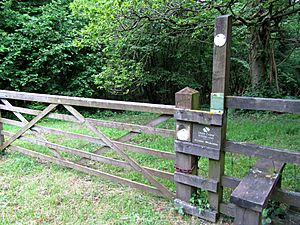Fiddler's Elbow National Nature Reserve facts for kids
Quick facts for kids Fiddler’s Elbow National Nature Reserve |
|
|---|---|

Entrance to Fiddler's Elbow National Nature Reserve
|
|
| Lua error in Module:Location_map at line 420: attempt to index field 'wikibase' (a nil value). | |
| Type | National nature reserve |
| Location | Upper Wye Valley, Monmouthshire |
| Nearest city | Monmouth |
| Area | 44.3 hectares (0.443 km2; 0.171 sq mi) |
| Operated by | Woodland Trust |
| Website | Countryside Council for Wales webpage |
Fiddler’s Elbow National Nature Reserve is a special woodland area in the beautiful Wye Valley, Wales. It's about 45 hectares (that's like 111 football fields!) and is located north of Monmouth, near the border with England. This reserve is protected because it's a "Site of Special Scientific Interest" (SSSI). This means it has amazing plants and animals that are important to protect. It's a great place to explore nature!
Contents
Exploring Fiddler's Elbow Nature Reserve
This nature reserve covers about 44 hectares. It was officially recognized as a special site in 1971. You can find it about 1 kilometer (0.6 miles) east of Monmouth town. It sits on the eastern banks of the River Wye.
The reserve includes different wooded areas. These are called Lady Grove, Priory Grove (in the north), and Garth Wood (in the south). A road called the A4136 road goes through the middle of the reserve. Also, the Offa's Dyke Path, a famous walking trail, runs through the southern part.
Part of the reserve is owned and looked after by the Woodland Trust. The other part is privately owned but managed with help from Natural Resources Wales. The whole area is also part of the Wye Valley Woodlands Special Area of Conservation. This means it's extra protected! The ground here is made of sandstone from a very old time called the Devonian period.
Amazing Plants of Fiddler's Elbow
Just like other woodlands in the Wye Valley Area of Outstanding Natural Beauty, Fiddler's Elbow is home to many unique and rare trees. You can find special areas with English oak (Quercus robur) and Cornish oak (Quercus petraea). There are also small-leaved lime trees (Tilia cordata) that have been coppiced.
Other common trees you'll see include common ash (Fraxinus excelsior), common beech (Fagus sylvatica), common hazel (Corylus avellana), and English yew (Taxus baccata).
Ground Plants and Flowers
The reserve is also famous for its beautiful ground plants. It's known as a "bluebell wood" because of the stunning bluebells that bloom in spring. Other spring flowers here include the common primrose (Primula vulgaris), lesser celandine (Ranunculus ficaria), ramsons (Allium ursinum), and wood anemone (Anemone nemorosa).
You can also find different types of orchids. These include the bird's-nest orchid (Neottia nidus-avis), early purple orchid (Orchis mascula), and the greater butterfly-orchid (Platanthera chlorantha). A very rare orchid, the ghost orchid (Epipogium aphyllum), has even been spotted here once!
Wonderful Wildlife of Fiddler's Elbow
You might be lucky enough to spot dormice living in the reserve. They love to munch on brambles, hazel nuts, honeysuckle, oak, and sycamore. Roe deer also live here. Sometimes, there are too many deer, and they eat too much of the plants. To protect the woodland, some areas are fenced off.
The people who manage the reserve have a special plan. They leave fallen trees and dead wood on the ground. This creates perfect homes for fungi and tiny creatures called invertebrates. It helps keep the whole ecosystem healthy and thriving!

